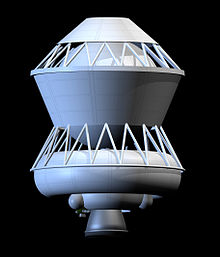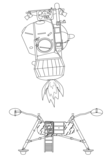Blok D
 Blok DM | |
| Country of origin | Soviet Union |
|---|---|
| Used on | N-1,ProtonandZenit-3 |
| General characteristics | |
| Height | 6.28 m (20.6 ft) |
| Diameter | 3.70 m (12.1 ft) |
| Gross mass | 17,360 kg (38,270 lb) |
| Propellant mass | 15,220 kg (33,550 lb) |
| Empty mass | 2,140 kg (4,720 lb) |
| Associated stages | |
| Family | Blok D |
| Derived from | Blok D |
| Derivatives | Blok DM-03 |
| Comparable | Briz-M |
| Launch history | |
| Status | Retired |
| Total launches | 66 |
| First flight | 1974-03-26 |
| Last flight | 1988-05-06 |
| Launch date | |
| Blok DM | |
| Powered by | RD-58M |
| Maximum thrust | 83.61 kN (18,800 lbf) |
| Specific impulse | 363.5 s (3.565 km/s) |
| Burn time | 630 seconds |
| Propellant | RP-1/LOX |
Blok D(Russian:Блок ДmeaningBlock D) is anupper stageused onSovietand laterRussianexpendable launch systems,including theN1,Proton-KandZenit.[2]
The stage (and its derivatives) has been included in more than 320 launched rockets as of 2015[update].[3]By 2002 its modification Blok DM had a 97% success rate in 218 flights since 1974, and 43 successful missions in 1997–2002.[4][5]
The stage was developed in the 1960s as the fifth stage ('Д' is the fifth letter in the Cyrillic alphabet) for the powerfulN1 rocketused in theSoviet crewed lunar programs.The stage first flew in March 1967 while testing theZondspacecraft as a part of those programs. During crewed lunar flight Blok D would be used for mid-course corrections on the flight to the Moon, then to place the lunar orbiter and lander into a lunar orbit, and deceleratemoon-landerout onto its landing trajectory.[6]
Blok D was also included as fourth stage ofProton-Kand as such flew on uncrewed Soviet missions to Moon,Mars(Mars 3) andVenus.It was used in theProton-Kconfiguration of the rocket and is still in use in the newerProton-Mvariant (along with theBriz-M).
Blok DM also flies as the third stage for the Zenit-3SL rocket, which is used by theSea Launchproject to launch geostationary satellites. In 2002 a Blok DM3 failed in the attempted launch ofAstra 1K.
The stage usesliquid oxygen(LOX) andkeroseneas propellants, and has one single-chamberRD-58main engine. The LOX tank has a spherical shape; the kerosene tank is toroidal, inclined to 15 degrees for better fuel extraction, with the engine mounted in the center of torus. Tanks include the first pump stage for the engine; the main pump is mounted on the engine.
Blok D weighs 3.5 tons during liftoff, but some parts are jettisoned and the dry mass in space is 2.5 tons. It has 5.70 meters length and generates 83.300 kN thrust for 600 seconds burn time. Blok D was modified asBlok DMin 1974, with 11D-58S engine. The unit cost is $4 million.[7]
As of the early 1990s, the ullage rockets discarded just before the final burns by Block DM fourth stages on Proton launches constituted the largest single group of soviet propulsion systems to have suffered disintegrations contributing tospace debris.[8]
Since 1990, all variations of this stage have been built in theKrasnoyarsk Machine-Building Plant.[9]
Modifications[edit]
RKK Energia,the company that created Blok D, used it as a platform for many modifications over many years for different purposes; for example, the main propulsion unit onBuranstarted as a modification of the Blok D.[10]
Variants[edit]
| Variant | First flight | Last flight | Launches | Rockets | Remarks |
|---|---|---|---|---|---|
| Blok D | 1967 | 1976 | 44 | Proton-K N1 |
|
| Blok D-1 | 1978 | 1989 | 10 | Proton-K | Mostly used for launches toVenus |
| Blok D-2 | 1988 | 1996 | 3 | Proton-K | LaunchedFobos 1,Fobos 2andMars 96 |
| Blok DM | 1974 | 1990 | 66 | Proton-K Energia(unflown) |
Blok D modification for Earth-based orbits |
| Blok DM-2 | 1982 | 2012 | 115 | Proton-K Proton-M |
Used with Proton-M forGLONASSlaunches[1] |
| Blok DM-2M | 1994 | 2005 | 15 | Proton-K | Enhanced payload thanks to the use of higher performanceSyntinfuel instead ofRG-1.Powered by theRD-58S engine. |
| Blok DM-5 | 1997 | 2002 | 2 | Proton-K | Used forlow Earth orbitlaunches with Arkas satellites |
| Blok DM1 | 1996 | 1996 | 1 | Proton-K | Commercial Blok DM-2, only used for one launch, withInmarsat-3 F2 |
| Blok DM2 | 1997 | 2002 | 4 | Proton-K | Commercial Blok DM-5, used forIridiumandINTEGRALlaunches |
| Blok DM3 | 1996 | 2006 | 25 | Proton-K | Commercial Blok DM-2M |
| Blok DM4 | 1997 | 1997 | 1 | Proton-K | Commercial Blok DM-2M, only used to launchTelstar 5 |
| Blok DM-SL | 1999 | 2014 | 36 | Zenit-3SL | Used inSea Launchmissions, some flights use a version with stretched fuel tanks |
| Blok DM-SLB | 2008 | 2013 | 5 | Zenit-3SLB | Used inLand Launchmissions and other commercialZenit-3SLBflights from Baikonur |
| Blok DM-03 | 2010 | active | 4 | Proton-M | Intended as a replacement for Blok DM-2 and DM-SL/SLB, first flew in 2010, only used on Proton |
| 14S48 Persei / Orion | 2021 | active | 1 | Angara A5 | Modification of 11S861-03 (DM-03) forAngara A5 |
| References | [3][11][12] | ||||
See also[edit]
- Blok DM-03– Advanced version of this stage.
- N-1– original launch vehicle for which this stage was developed.
- Proton– launch vehicle that has flown the most with this stage.
- Zenit-3– launch vehicle that uses this stage.
- Angara A5– launch vehicle that will use this stage when launched fromVostochny Cosmodrome[13]
References[edit]
- ^Norbert Bgügge."Proton Design (3)".Retrieved1 August2015.
- ^"Upper stage Blok DM, DM-SL".RSC Energia.Archived fromthe originalon 9 May 2012.Retrieved30 June2013.
- ^abKrebs, Gunter."Blok-D - Gunter's Space Page".Retrieved1 August2015.
- ^Zak, Anatoly."Rockets: Launchers: N1: Block D".RussianSpaceWeb.com. Archived fromthe originalon 19 September 2007.Retrieved20 September2007.
- ^"Sea Launch Stands Behind the Reliability of the Block DM".Boeing (press release). Archived fromthe originalon 5 February 2003.Retrieved20 September2007.
- ^"11D-58 - Summary".Andrews Space & Technology. Archived fromthe originalon 19 September 2000.Retrieved20 September2007.
- ^"Block DM 11S86".Archived fromthe originalon 23 July 2008.Retrieved26 September2008.
- ^Clark, Phillip."SPACE DEBRIS INCIDENTS INVOLVING SOVIET/RUSSIAN LAUNCHES".Archived fromthe originalon 25 October 2021.Retrieved7 February2023.
- ^"Rocket Space Technology/Upper Stage".www.krasm.com(in Russian). JSC Krasnoyarsk Machine-Building Plant.Retrieved10 June2015.
- ^Hendrickx, Bart; Vis, Bert (2007).Energiya-Buran: the Soviet Space Shuttle(Online-Ausg ed.). Berlin: Springer. p. 127.ISBN978-0-387-69848-9.
- ^Norbert Bgügge."Proton".B14643.DE.Retrieved1 August2015.
- ^"Block DM-2M 11S861-01".Encyclopedia Astronautica. Archived fromthe originalon 14 June 2006.Retrieved31 July2015.
- ^Zak, Anatoly (11 June 2015)."Angara to replace Proton".RussianSpaceWeb.com. Archived fromthe originalon 6 September 2015.Retrieved8 September2015.

